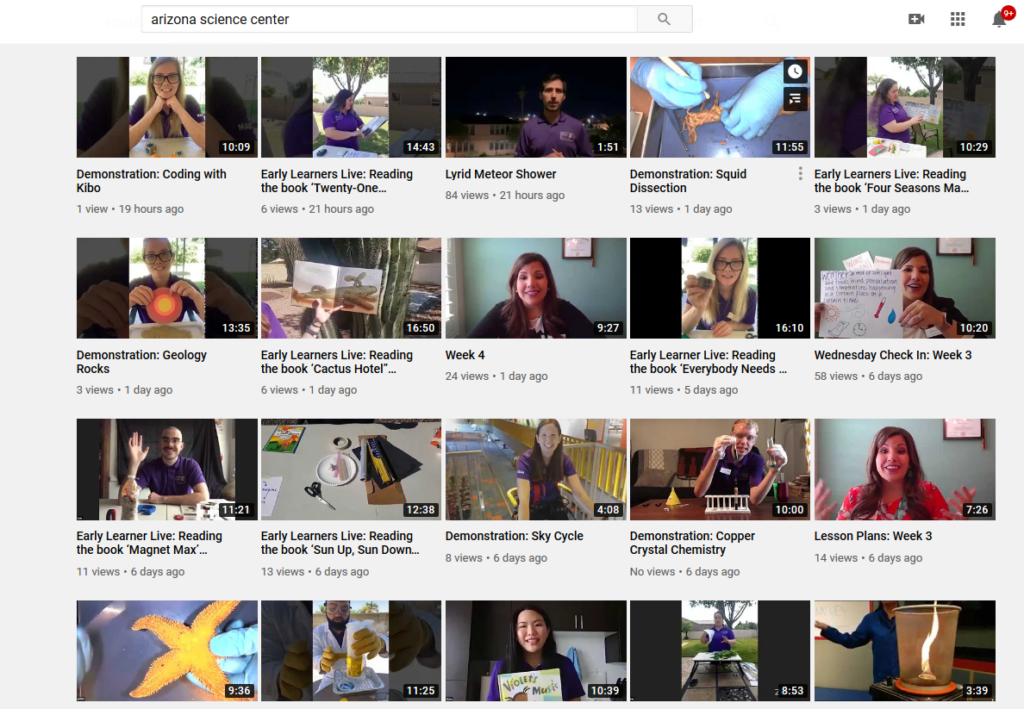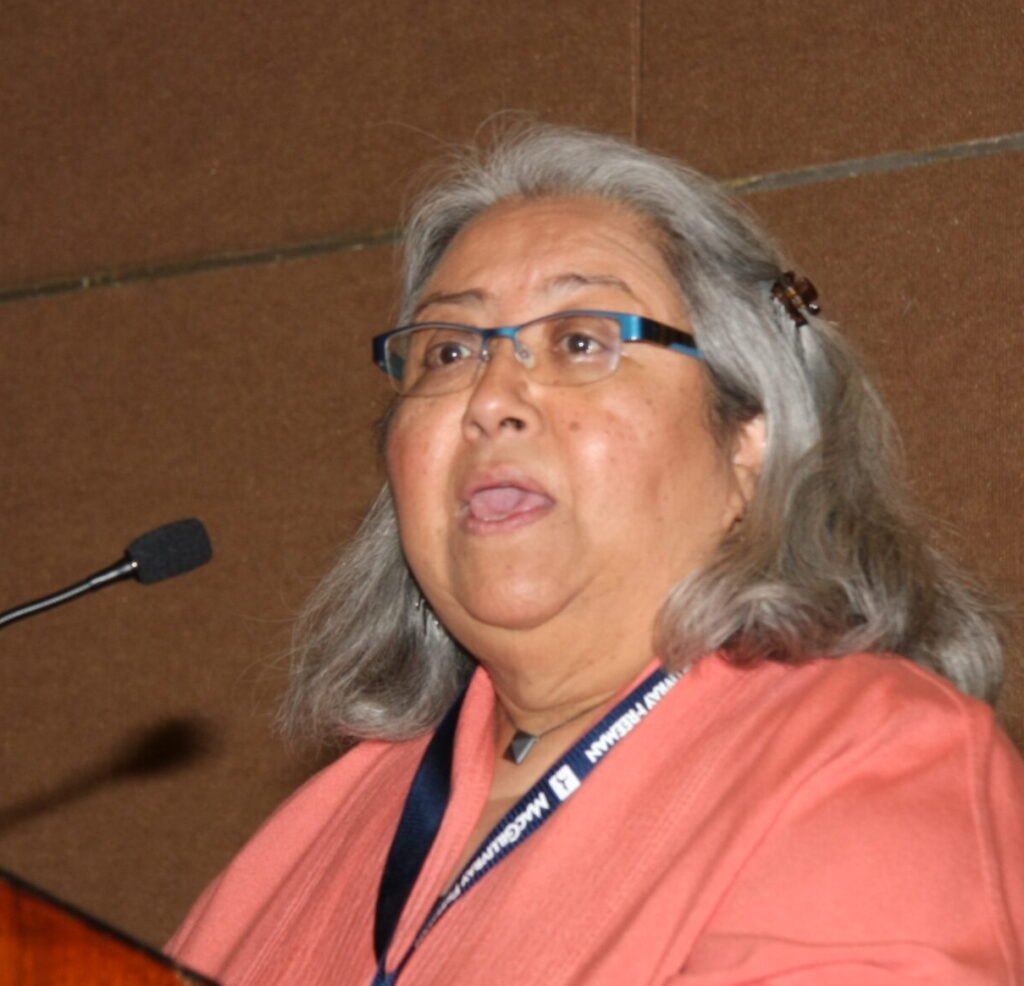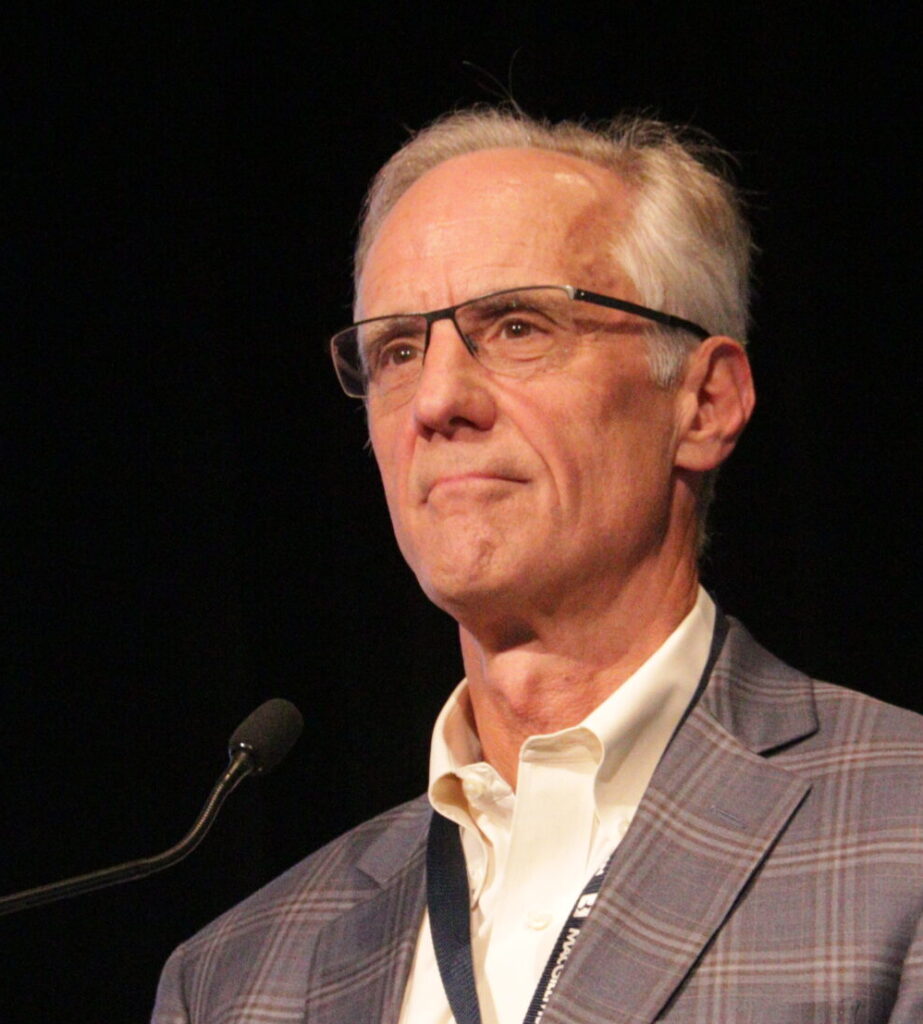Alan Nursall, CEO of Telus World of Science Edmonton, demonstrating science from his kitchen.
Sidebars:
Diane Carlson on Preparing to Reopen
Paul Fraser on the Post-COVID Future of the GS Business
Severe Acute Respiratory Syndrome Coronavirus 2 (SARS-CoV-2), the virus that causes the coronavirus disease 2019 (COVID-19), referred to henceforth simply as “coronavirus,” has temporarily closed at least 90% of all giant-screen and IMAX theaters worldwide since the outbreak was declared a pandemic in mid-March. This article will document the effects of the outbreak and the responses to it by the giant-screen world.
The disease was first identified in Wuhan, China, on Dec. 31, 2019. On Jan. 22, 2020, when the death toll stood at 26, major studios decided to delay the openings of seven major blockbuster films in China that had originally been scheduled for the Chinese New Year holiday, Jan. 25 to Feb. 4. Imax Corporation issued a statement on Jan. 23 supporting the decision. In the next few days, museums and other tourist attractions throughout China began closing, along with some 70,000 multiplex theaters, including more than 700 IMAX screens.
By early March, the virus was present on every continent except Antarctica, and dozens of museums with giant-screen theaters in Taiwan, South Korea, Japan, and Kuwait had closed, including the National Science and Technology Museum in Taipei, the National Science Museum in Daejeon, Science Museum, Osaka, and the Scientific Center of Kuwait. Throughout the first two weeks of March, multiplex IMAX theaters in Italy, Slovakia, Japan, Denmark, Poland, Greece, and Norway closed.
According to an extensive survey LF Examiner has made of the Web sites of virtually all GS theaters in the world, the first U.S. museum with a GS theater to close was the Museum of Science Boston, which shut down on March 12. The Eugenides Planetarium in Athens, Greece, closed the same day, followed on Friday, March 13 by more than a dozen other institutions in the U.S., Canada, Greece, Denmark, and the Netherlands. The Smithsonian Institution closed the National Zoo and 15 museums (including two with IMAX theaters) in the Washington, DC, area on March 14. In the following week, at least 100 more institutions with GS theaters closed. AMC Theatres, Regal Entertainment, and Cinemark, the three largest theater chains in North America, closed their combined 1,524 locations, including more than 425 IMAX screens, on March 17. Nearly all smaller exhibitors in North America followed suit over the next week.
On March 18, as new cases in China seemed to be approaching zero, Imax CEO Richard Gelfond told The Hollywood Reporter, “I’m hoping — and a lot of this is subject to biology — that by June things will be somewhat more normal over there.” The following day, Macquarie Research said that Imax’s “pristine balance sheet,” lack of debt, and $100 million in cash meant that the company could hold out for “at least two years.” The report led to a 60% jump in the price of Imax stock, from $7.20 on March 18 to $11.47 the next day. (A month earlier the shares had been trading at $17.10, with a 52-week high of $25.36.) As this issue went to press on April 22, Imax shares were trading at $11.06.
On March 23, the Chinese government allowed about 500 (non-IMAX) theaters — less than 5% of the country’s total — to reopen, but they sold a combined total of only $2,000 of tickets on the first day. Less than a week later, they were all ordered closed again.
A few days later, AMC sent a letter to its landlords in North America saying that it would stop paying rent as of April 1, and reportedly began preparing to file for Chapter 11 restructuring of its $4.9 billion in debt. However, on April 16, it announced that it is raising $500 million in new debt to strengthen its balance sheet, which eased analysts’ concerns.
Status of institutional theaters
By early April, of the 212 non-multiplex GS theaters in LF Examiner’s database, 193 (91%) were confirmed closed. The Toyohashi Museum of Natural History in Japan was one of the last to close, shutting its doors on April 14. At press time only two appeared to still be open, according to their Web sites: the National Planetarium in Kuala Lumpur, Malaysia and National Museum of Marine Science & Technology in Keelung, Taiwan. Both were using enhanced sanitizing and social distancing procedures. (We were unable to determine the status of 17 others, mostly in China, and either have no Web sites, or give no sign of their status on the site.)
When first announcing their closures, about 80 theaters said they intended to reopen in a few weeks, some setting dates less than two weeks out. But by the time those dates arrived, all had pushed back their projections. Half of them set new dates between 14 and 90 days further out, but the rest simply said they would remain closed until further notice.
With the closures, many institutions began posting videos and other material to help their visitors and members educate and entertain children, pass the time during quarantine, and keep the museum in mind until things get back to normal.
(This last point was a top recommendation from data analyst Colleen Dilenschneider, who posted several reports on the effect the coronavirus may have on cultural institutions, and what they can do to remain relevant and useful to their visitors while closed. Her report on why marketing during the closure is important, and many other studies, can be found at colleendilen.com.)
The content being posted by museums is varied, and includes lesson plans, activity guides, and other previously prepared materials, but leans heavily to newly created videos. Several common themes have emerged: “Science at Home” videos, recorded in staffers’ homes; science demos of the kind previously offered live in the museum; story times, with staffers reading science-related picture books for young kids; talks about specific museum exhibits; and talks by or interviews with staff scientists or GS filmmakers about their work.
Alan Nursall, chair of the Giant Screen Cinema Association and CEO of Telus World of Science Edmonton in Alberta, Canada, has filmed several videos in his kitchen (as have other TWOSE staffers in their homes), to demonstrate simple principles of science that viewers can recreate using materials around the house.
As a typical example, Ohio’s Cincinnati Museum Center has posted a live video feed of its aquarium; a Facebook live session with a staff paleontologist describing her job and research; and a staffer reading a story book, Ada Twist, Scientist.

The Hastings Museum in Nebraska filmed a new series of videos in the empty building, called Museum Minute, with staffers offering behind-the-scenes looks at exhibits, and explaining scientific principles, such as how germs are spread. They also began a story time series, shot near relevant exhibits, for instance a story about a bear filmed next to a diorama with a bear.
IMAX Victoria, located inside Canada’s Royal B.C. Museum, is posting new content in the form of remote video interviews with GS filmmakers. To date, the theater’s Lea Silver has interviewed sound engineer and Victoria resident Tim Archer of Masters Digital, Superpower Dogs director Daniel Ferguson, and GS veteran Greg MacGillivray. The live feeds are only offered to holders of its annual pass, but the recorded videos are later posted on the theater’s Web site.
The Tennessee Aquarium in Chattanooga has posted more than live 40 videos to its Facebook page, running from a few seconds to an hour, featuring shots of the animals and their handlers feeding them and answering questions from viewers.
Although many museums are posting a few new videos each week, some are going further and posting videos every day, or even more frequently. The Great Lakes Science Center in Cleveland, OH, streams live videos from its building every day at 10:30 am, and (as of press time) has racked up more than 84 new videos since closing on March 13.
The Arizona Science Center in Phoenix has topped that, posting 88 live videos from the museum or staffers’ homes.

Most museums are also e-mailing and posting new requests for donations on their sites.
LF Examiner has checked the Web sites of virtually all GS institutions in the western hemisphere for new “lockdown” content. We have posted those links on a new page here. We have also updated the Web site’s Theaters page to include their current status: closed, open, or unknown.
We welcome additions and updates, especially from organizations in the Asia-Pacific region. Please use the Web site’s contact page.
Producers’ responses
So far, two producer/distributors have released full-length GS films for free streaming at home: Giant Screen Films and MacGillivray Freeman Films. The titles available are:
Giant Screen Films:
- Dinosaurs Alive (2007)
- Mummies (2007)
- Wild Ocean (2008)
MacGillivray Freeman Films:
- The Living Sea (1995)
- Dolphins (2000)
- Coral Reef Adventure (2003)
- Van Gogh (2009)
- Humpback Whales (2015)
- National Parks Adventure (2016)
- Dream Big (2017)
- America’s Musical Journey (2018)
Cosmic Picture posted a “takeover” of its Facebook page by Henry, one of the rescue dogs featured in Superpower Dogs and a discussion about its 2013 film, Jerusalem, with director Daniel Ferguson.
SK Films has created an “Explore at Home Kit” that is available for free at its Web site. The 38-page PDF file features educational materials prepared for its GS films, including Flight of the Butterflies (2012), Amazon Adventure (2017), Backyard Wilderness (2018), and Volcanoes: Fires of Creation (2018).
Fulldome system and content supplier Evans & Sutherland is helping dome clients by making flat-screen HD versions of four fulldome titles available for free streaming. (The videos include an anti-piracy text crawl.) E&S dome theater clients, like the U.S. Space & Rocket Center in Huntsville, AL, are creating and posting videos using imagery from their Digistar systems.
Other responses
By mid-March several movie and entertainment industry conferences had been canceled or postponed: CinemaCon 2020, originally set for April 26–29 in Las Vegas; the International Planetarium Society’s 2020 conference, set for June 21–25 in Edmonton, AB, Canada, which was to include a Giant Screen Day and be contiguous with the IMERSA Summit, has been canceled; and the Themed Entertainment Association’s Summit and Award Gala, originally planned for April 16–18 in Anaheim, CA, has been postponed to July 9–11. The TEA/SATE Europe conference has been rescheduled from May 2020 to May 2021 in Barcelona, Spain, with exact dates to be announced.
The Giant Screen Cinema Association has responded to the crisis with a new forum at its Web site that allows members to discuss their professional and personal reactions to the pandemic. The association is also hosting periodic online video meetings that have drawn as many as 80 GS professionals to talk about the situation.
In a statement, executive director Tammy Seldon said, “We understand that many GSCA members’ travel budgets may be reduced or eliminated completely, and that some may be reluctant to travel in September. We are in discussions with the hotel to determine options for the GSCA 2020 conference, currently scheduled for September 21–24. We are exploring all options, including a smaller in-person event, a virtual event, or a hybrid. You will receive a survey soon to help us in our planning, and the Event Planning Committee and Board will provide updates when possible. We hope to have a final decision in early June.”
Films in production
Among the few projects still actively shooting (or trying to) is Secrets of the Sea from Oceanic Research Group and Howard Hall Productions. Director Jonathan Bird (based in Massachusetts) tells LFX, “We had to cancel a planned shoot in the Bahamas in April that will be rescheduled. I was planning mostly local filming (New England and Eastern Canada) for the spring and summer, so that will go on as scheduled. Howard and Michele Hall will continue with some west coast filming that they were planning, once the lockdown comes to an end. We expect that coronavirus will not delay the [spring 2021] release of the film. However it may be that we hold back release, depending on how things look in the market.”
Bird’s latest film, Ancient Caves, nominally opened on March 7, but obviously had very few screenings before theaters began shutting down.
The Stephen Low Company’s Pietro Serapiglia says that Train Time, originally set to open this month, is complete, except for the IMAX digital and film versions, which can’t be finished until IMAX Post and FotoKem, the lab that produces the films prints, reopen for business. Serapiglia doesn’t expect to be able to release the film this year.
GS film release dates
Four GS films have nominally been released since Jan. 1, 2020:
| Title | Distributor |
| Into America’s Wild (2/14) | MacGillivray Freeman |
| Dinosaurs of Antarctica (2/14) | Giant Screen Films |
| Sea Lions: Life by a Whisker (2/15) | K2 Studios |
| Ancient Caves (3/7) | MacGillivray Freeman Films |
However, they had only opened on a handful of screens by the time theaters began closing in mid-March. Their producers and distributors hope they will retain the bookings when theaters reopen, but the whole issue of how and when theaters should re-launch remains an open question. (See Diane Carlson’s article below.)
Most of the original GS films currently in production have completed principal photography and are in post-production. These include:
| Title | Production Company |
| America’s Arctic | Terra Mater |
| Angkor: Lost Empire of Cambodia | Definition Films |
| Asteroid Hunters | Imax Corporation |
| Ireland | MacGillivray Freeman Films |
| Journey to the Great Mayan Reef | Milbrand Cinema |
| Snow | Saint Thomas Productions |
| Tiger, Tiger | White Mountain Films |
| Train Time | Stephen Low Company |
Although some post facilities are closed, and some types of work can’t be done during the lockdown, other work is proceeding, although generally at a slower pace because of the uncertainty surrounding the reopening of theaters.
No producer has given us a firm release date for any film that was originally expected to open in 2020. As mentioned above, some are still hoping to hold onto 2021 dates, but admit they will have to be flexible and respond to the situation as it develops.
Hollywood releases
Although Hollywood has scrambled to reschedule some of its biggest films, some summer blockbusters are still set (as of press time) to open on their original dates. Several of the DMR films that only appeared briefly in theaters before the shutdown are now available for streaming at premium prices (e.g., for a $20 rental instead of the usual $4–6 six months after the theatrical run), including Onward, Bloodshot, I Still Believe, and A Quiet Place Part II.
Titles moved from their original spring or summer release dates include Mulan, which has moved from March 27 to July 24; the next James Bond film, No Time to Die (from April 10 to Nov. 25); Black Widow (from May 1 to Nov. 6); Fast & Furious 9 (from May 22 to April 2, 2021, the date originally set for F&F 10); and Top Gun: Maverick (from June 26 to Dec. 23).

of dormant multiplex IMAX film projectors doesn’t begin soon.
However, some July and later release dates are mostly unchanged, as of this writing. Most notably, Christopher Nolan’s Tenet is still scheduled for July 17, even though its planned release in up to 40 IMAX film theaters will require several months of preparation to return a dozen or more dormant multiplex 15/70 projectors to working condition, hire and schedule projectionist crews for each location, and order and produce prints. (Nolan’s GS releases have averaged 146 minutes.) Sources tell LFX that those preparations have not yet begun. If they do not start in the next few weeks (or if the date is not moved), the 15/70 release might be limited to institutional theaters with staff projectionists and working 15/70 systems that would need no prep time. This would cut the number of screens roughly in half, and eliminate the most popular and lucrative locations in New York, Los Angeles, and San Francisco, dramatically reducing attendance and revenues from film screenings
Entertainment reporter Scott Mendelson points out in an April 16 article at Forbes.com that “Tenet would make for an ideal test case, presuming North America and/or the rest of the world is ready to try and get back into theaters. It’s an extremely anticipated would-be blockbuster that was expected, before the current madness, to be one of the year’s biggest domestic and global grossers.”
But considering its $200 million budget, and Nolan’s passion for screening his movies on film, not only 15/70, but also 5/70 and 35mm, it would not be surprising if he and Warner Bros. ultimately opt to delay the release for several months.
Warner’s Wonder Woman 1984, originally expected on June 5, was pushed back only two months, to Aug. 14. Like Tenet, it has “IMAX DNA,” i.e., it was partly filmed with IMAX-certified digital cameras, so a run in IMAX theaters is essentially mandatory. Unlike Tenet, Wonder Woman 1984 will not have a 15/70 release, so it could become the bellwether for the return to multiplexes if Tenet is postponed. Or it could be delayed once more, further scrambling the fall release schedule.
Two of the other big blockbusters were filmed with IMAX-certified digital cameras: MGM’s No Time To Die and Paramount’s Top Gun: Maverick, and their rescheduling to November and December of this year respectively has stolen the thunder of other titles that might have looked for an IMAX release. They include Warner’s Godzilla vs. Kong, which had already been moved from a March release to Thanksgiving week. Top Gun’s move to Wednesday, Dec. 23, will probably limit the IMAX run of WB’s Dune, which opens on the previous Friday.
The effect on business
LFX has had confirmation from one U.S. museum director that hourly employees have been temporarily laid off, and has heard rumors of layoffs at other institutions. On the other hand, Charlotte Brohi writes that Joel Bartsch, president of the Houston Museum of Natural Science, “has stated he plans to pay all part-time and full time salaries for the duration.” (When the print edition went to press, the museum’s Web site said it would reopen on May 1, but it now no longer states a date.)
Bob Perkins, president of Destination Cinema, Inc., reports that with its five theaters closed, “hourly staff has moved over to unemployment insurance and are waiting to come back to work. We expect to reopen by the summer season.”
Berend Reijnoudt, director of Omniversum, an IMAX Dome theater in the Netherlands, says that most of his staff has been laid off and is receiving unemployment benefits (which he explains “are not bad in the Netherlands”) and will be rehired when the theater reopens. In the meantime, he is using the down time for “small maintenance,” and having management meetings via MS Teams, Goto, and WhatsApp, which, he reports “really work well.” He adds, “I see this as the only upside at the moment.”
Producers, distributors, and other suppliers we have heard from are doing their best to continue despite the challenges and uncertainty. Greg MacGillivray tells LFX:
“We at MFF have six people working at our office, in separate rooms, and the other 24 people working at editing suites or offices at home. Because we have other projects besides those destined for giant-screen or IMAX theaters, we are currently able to keep everyone busy and happy. Every two days there is a production and post-production Zoom conference call, and every two weeks we are having a group Zoom video conference with all MFF staff. Because we’re a tight-knit team, many of us having worked together for decades or more, the Zoom conferences are a real benefit and upper.”
Don Kempf at Giant Screen Films and Pietro Serapiglia at the Stephen Low Company both say that although they are going in to their offices occasionally, the rest of their staffs are doing what work is needed from home. Neither expects to have to lay off employees. Rick Gordon of RPG Productions gave a similar report.
Several organizations told LFX that they were applying for loans under the Paycheck Protection Program of the $2 trillion economic stimulus bill that would cover two months’ worth of salaries and certain other expenses, and would in most cases not need to be repaid.
What the future holds
In the current circumstances, the only certainty about the future is that it is nearly impossible to predict. Everyone hopes for a quick return to normality and business as usual, but previous epidemics and pandemics teach that ending quarantines too early rarely works out well: a second wave of contagion often flares up after the first wave drops off.
The best case scenario is a vaccine against the virus, and many candidates are currently being tested, but there is no guarantee that one will be discovered. Treatment for the symptoms of AIDS has become very effective over the past 40 years, but no vaccine has been developed to prevent the HIV virus from infecting people. WHO says that the soonest a COVID vaccine could become available is about 18 months, but concerns about being in large crowds could linger in a significant portion of the public long after that.
However, most GS industry people we spoke to were hopeful that our community would pull through. Much of the discussion in the GSCA’s online meetings has been about strategies for reopening theaters, such as initially selling a reduced number of seats to allow visitors to maintain adequate social distancing. In a letter to LFX (see April 2020, page 2) director Jonathan Bird points out that 20-minute versions of GS films may become much more popular, because the more frequent turnaround times can partly compensate for lower per-show capacities.
GS veteran and consultant Paul Fraser of Blaze Cineworks provides a thoughtful look forward below.
MacGillivray says, “We want to make certain that everyone in our industry keeps healthy and happy during this trying time. Stay sequestered, and like previous downturns, have confidence that because we offer the highest quality entertainment in our films and at our theaters, and provide a unique source of inspiration and information to our customers, we will survive.”
RPG’s Gordon agrees. “I think we’ll recover. I’m hopeful that theaters, producers, distributors, and other types of companies (like ours) will plunge back in with renewed energy and a sense of the mission to which we are all dedicated.”
Diane Carlson on Preparing to Reopen
Looking forward to when cultural institutions will reopen, how can our GS industry prepare? First and foremost, and although it may be a cliché, it is true of our small industry that we are all in this together. And the best way to move forward is together, pooling ideas and planning strategically and tactically.

While some of our members, both private and institutional, may not survive the economic upheaval, we can all work together to return as strong as possible. I see it like launching a three-stage rocket.
In the first stage, don’t let them forget you! Theaters must keep in touch with and support their audiences, including current members and pass holders as well as past individual ticket buyers. Supply them with information about our films, identifying those GS titles that are now available online, and providing links to educational materials and film-related trivia. Remind them of the entertainment and educational value of our programs.
If you have photos of film talent at your facility for one of the films that is now available online, personalize your outreach message with a photo of the talent at your location, or perhaps a local interview. You have brought creative, engaging, and beautiful programming to your community: don’t let them forget this. And even if a film is not available online, its education materials are. Many of these materials were written for broader audiences than formal classroom teachers; parents can easily use them. I know this first-hand, because in the cases of the guides for Pandas and Superpower Dogs, I helped create them!
For stage two of our rocket launch, we need to inform and excite our audiences about our reopening films. Educational materials, behind-the-scenes stories, and photos and bites of information taken from production notes are all great tools. Get them interested in the topic and film before you reopen. Make up trivia contest questions based on information from the film that families can quiz each other about. Build excitement so that they will want to return to your theater.
Stage three is planning the launch of your return to operation. How will you inform your public that you are a safe place to visit again? A place to spark creativity and excitement? What kind of celebration will you plan? What is the plan after the opening week?
It will probably take at least three to six months after reopening before any kind of normality returns. There will be a pent-up desire to go out, but there will be caution. Research from IMPACTS Research and Development’s Colleen Dilenschneider has shown that “high-touch” places and enclosed theater and performance halls will have a more challenging time upon reopening than open-air facilities like zoos.
Insist that your 3D glasses cleaning machine supplier certify that the unit sanitizes the glasses. Or consider opening with 2D screenings only. Make hand sanitizer readily available. Reduce the theater capacity in your ticketing system to allow guests to spread out.
Assure potential guests that you are meeting or exceeding all of the guidelines for safe operation. For example, start planning for routine temperature checks of your staff before they enter the facility. Review every area of the operation that could be a source of guest concern, starting with your admission procedures. Think creatively about ticketing options; for example, institute a multi-day day pass so that guests can make shorter visits, or leave if they feel it is getting too crowded, knowing that they can return without penalty. Many families will be hard hit financially, so creative thinking about new ticketing options will be important.
This is also a great time to rally staff across the organization to come together to support the theater effort and for theater staffers to show how they can support the mission of the organization and other units. Don’t miss this opportunity to work creatively as a united institution to reengage with audiences.
Diane Carlson is principal of Giant Screen Cinema Consulting. Before founding the firm in 2017, she managed the IMAX theaters at the Pacific Science Center in Seattle, WA, for over 35 years. She can be reached at [email protected].
Paul Fraser on the Post-COVID Future of the GS Business
LF Examiner asked a number of GS industry leaders for their opinions about what the future holds for our world, expecting only a few sentences from each. Most of those responses are included in the main article. Industry analyst and consultant Paul Fraser of Blaze Cineworks went far beyond with this thoughtful essay, which we are including in its entirety.
Virtual reality consultant and Forbes columnist Charlie Fink, who was featured in a recent online video interview on the future of work, post-COVID-19, said something that I thought rang quite true. To paraphrase him, this COVID crisis is teaching us, as a society, that almost everything that should have changed pre-crisis has changed quickly, or is in the process of changing now: tele-medicine, online meetings, distance education, and so on.

We can apply this thinking to the GS industry. It puts even more emphasis on looking at new models for doing business, and may even lead to changes to our industry’s main product: the giant-screen documentary.
The future for all the stakeholders in the GS business will turn first on how theaters do over the next year or two. The vast majority are in museums or science centers, and admission to the theater is combined with building admission for about 90% of theater visits. So the survival of most GS theaters will depend at first on the ability of their host institutions to survive with zero revenues for a while, and probably, once they re-open, with much lower revenue than before the shutdown.
The next question (and big unknown) is how long it will take for people to visit theaters at the levels they did pre-shutdown. People may be quite willing to walk through large exhibit halls where social distancing is easier, but will they want to sit in a theater, in close proximity with a lot of strangers, before a vaccine is in full use? Theaters are considering making a number of building and operational changes when they re-open, but will measures like only selling half of the theater’s capacity help ease those concerns?
How many GS theaters and institutions have depended on out-of-state (or province) and out-of-country visitors for a good portion of their attendance? Travel, especially air travel, will likely take a while to bounce back.
For organized school groups, not only may educators be faced with pushback from concerned parents about their kids going to theaters, but schools and parents will be financially strapped and likely to cut back on their spending for school trips to GS theaters.
The ripple effect is that distribution revenues will be down for a while, too. For filmmakers, investing equity capital in GS films was already hard to justify on its economic merits, but with lower per-theater and overall license revenues, the appetite for any investor (or producer) to risk an equity investment may just vanish for good. This will put even greater pressure on raising “free” or “non-participating” funds from corporate sponsors, grant-making organizations, and government agencies, but these sources will likely have less money to contribute and/or they will be deluged with funding requests. All this is likely to slow the pace of film development for the next couple of years, lead to lower production budgets, and reduce the number of new releases starting next year.
Bottom line, while we shouldn’t discount the positive effect of pent-up demand, I think it will likely take until at least spring 2022 before we see a return to anything close to pre-shutdown levels of theater attendance. For some historic perspective, we could look at what happened to the GS industry after the financial market collapse in late 2008. GS theater attendance took a big hit, as did so much of the economy. In general, attendance levels eventually came back to a decent extent, but the new plateau fell well short of pre-2008 attendance levels. I believe there were other forces that held GS theaters back from completing a full rebound, so the worry now has to be that the recovery from the COVID shock may never get us back to our 2019 levels. It’s difficult for any of us to forecast what the new normal will look like (though it’s a quantitative exercise I may tackle), but as in the post-2008 period, there are other headwinds and changes in the broader entertainment landscape that museums and their theaters will have to navigate.
As the saying goes, “never let a crisis go to waste.” My own glass-is-half-full view is that the GS industry is presented with an opportunity to re-invent itself. It’s time to invent new ways to do business, new ways to engage visitors, new creative approaches to the GS film, and new channels of distribution and partnerships. I’ve had a number of stimulating conversations with various people in recent weeks. Weirdly, amidst the gloom we’re facing today, it’s kind of an exciting time.
Paul Fraser is president of Blaze Cineworks LLC, an independent consulting and project management firm that serves clients in a wide array of out-of-home immersive media experiences. www.BlazeCineworks.com


Comments are closed, but trackbacks and pingbacks are open.